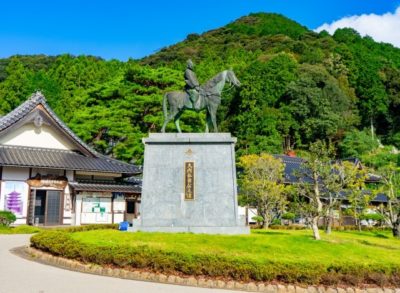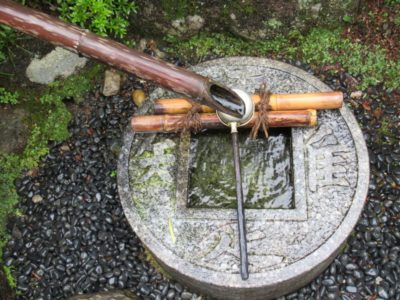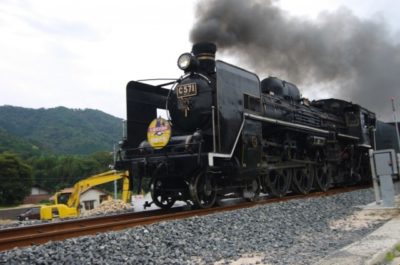Yamaguchi City in Japan is not a well-known city amongst foreign tourists, but if you travel in Honshu’s southwestern area near Hiroshima, a visit is worth it! The city has a long history and boasts impressive historical temples and shrines, and train enthusiasts will love taking a ride on the steam locomotive.

History of Yamaguchi City
Yamaguchi was built in the middle of the 14th century by a warlord of the Ouchi family in imitation of Kyoto, which is why Yamaguchi City is often referred to as ‘Western Kyoto’.
In the 16th century, Ouchi was attacked by the Mori clan who had a base in Hiroshima, and that was the end of the Ouchi family. In the Edo period, the base of the Mori clan was moved from Hiroshima to Hagi which is located in the northern part of Yamaguchi Prefecture.
After Hagi had become the center of the Mori domain, Yamaguchi was given to the Yoshiki Mori family branch until the middle of the 19th century. Then, Yamaguchi started to flourish as a center of politics in the west. The Mori family contributed a lot to the Meiji Restoration that finished the Tokugawa Shogunate.
Rurikoji Temple

There are many popular historical sites in the city such as longstanding temples. Rurikoji is a Buddhist temple famous for its beautiful old five-storied pagoda which was constructed in the mid 15th century by the Ouchi family. The water basin pictured above bears Chinese characters saying “I only know that I am content”.
The pagoda’s height is 31 meters. It is the 10th oldest five-storied pagoda and listed as one of the top three pagodas in Japan as well as the ones in Horyuji Temple in Nara and Daigoji Temple in Kyoto. Also, it was designated as a National Treasure. The roof is made of cypress bark. There is a pond in front of the pagoda. The view over the pond is really beautiful.
Yamaguchi St. Francisco Xavier Church
St. Francisco Xavier was a member of the Society of Jesus and he came to Japan in 1549 as a Catholic missionary. He was the first person who brought Christianity to Japan.
Yamaguchi St. Francisco Xavier Church was constructed in 1952 to commemorate 400 year anniversary of Xavier’s visit to Yamaguchi. The first church was an imitation of Xavier Castle in Spain. After a fire, the new church was reconstructed in 1998 made possible by donations from the local people. It is a modern style church with the shape of a tent with two towers.
Other Temples and Shrines
There are many other important temples in the city. Ryufukuji Temple was also founded by Ouchi family. The beautiful main hall called Shakado from the 16th century is designated as a National Important Cultural Asset.
Joeiji Temple is famous for its beautiful garden. It was designed by the famous painter Sesshu. He was a Zen Buddhist monk but also an artist of ink blush painting. He painted mainly beautiful sceneries. The garden he made here is a pond strolling garden, but he included the technique of a dry landscape garden. He added a dry waterfall, which means that he made a waterfall with a combination of rocks without using water.
Yamaguchi Daijingu nickenamed as the Ise Shrine in the west was founded in 1520 by the Ouchi family. Ise Shrine is the most important shinto shrine in Japan which enshrines Amaterasu or the goddess of the sun who is believed to be the ancestor of the Japanese Imperial Family. This Yamaguchi Daijingu also enshrines Amaterasu.
Yamaguchi City Steam Locomotive

While you are in Yamaguchi, it is recommended to also experience a ride on the steam locomotive SL Yamaguchi. The train is running between Shin-Yamaguchi Station and Tsuwano Station on the JR Yamaguchi line. JR, which used to be Japan National Railway, finished the operation of steam locomotives in 1975, but the Yamaguchi Line restarted operations in 1979 for the tourists.
They operate the SL only on the weekends of the tourist season and special holidays, so you’d best check the dates of the operation if you want to try it. You can check the dates in Japanese (updated) or in English (make sure it’s updated).
Local Food
Shicchoru-nabe is a special hot-pot dish of Yamaguchi. It was made recently by the local people. There are 4 different patterns by the four seasons. They put local ingredients by the season. ‘Shicchoru’ literally means ‘I know’. So they want everyone to know about it.
Uiro is a Japanese sweet. You may find it in many different places, but the one in Yamaguchi is special. They mix bracken powder and sugar, then steam it. They sometimes add azuki beans or matcha powder.
Your Japan Tour
As seasoned Japan experts, we create perfect Japan package tours including destinations like Yamaguchi. Check out our group tours and private tours, or contact us to start planning your unforgettable holiday to this fascinating country full of once-in-a-lifetime experiences, culture, history, nature, and delicious food!
Information
Access to Yamaguchi Station (JR):
From Shin-Osaka Station: Take Shinkansen (bullet train) to Shin-Yamaguchi. Then take Yamaguchi Line to Yamaguchi. It takes about 3 hours.
From Hakata Station: Take Shinkansen (bullet train) to Shin-Yamaguchi. Then take Yamaguchi Line to Yamaguchi. It takes about 1.5 hours.